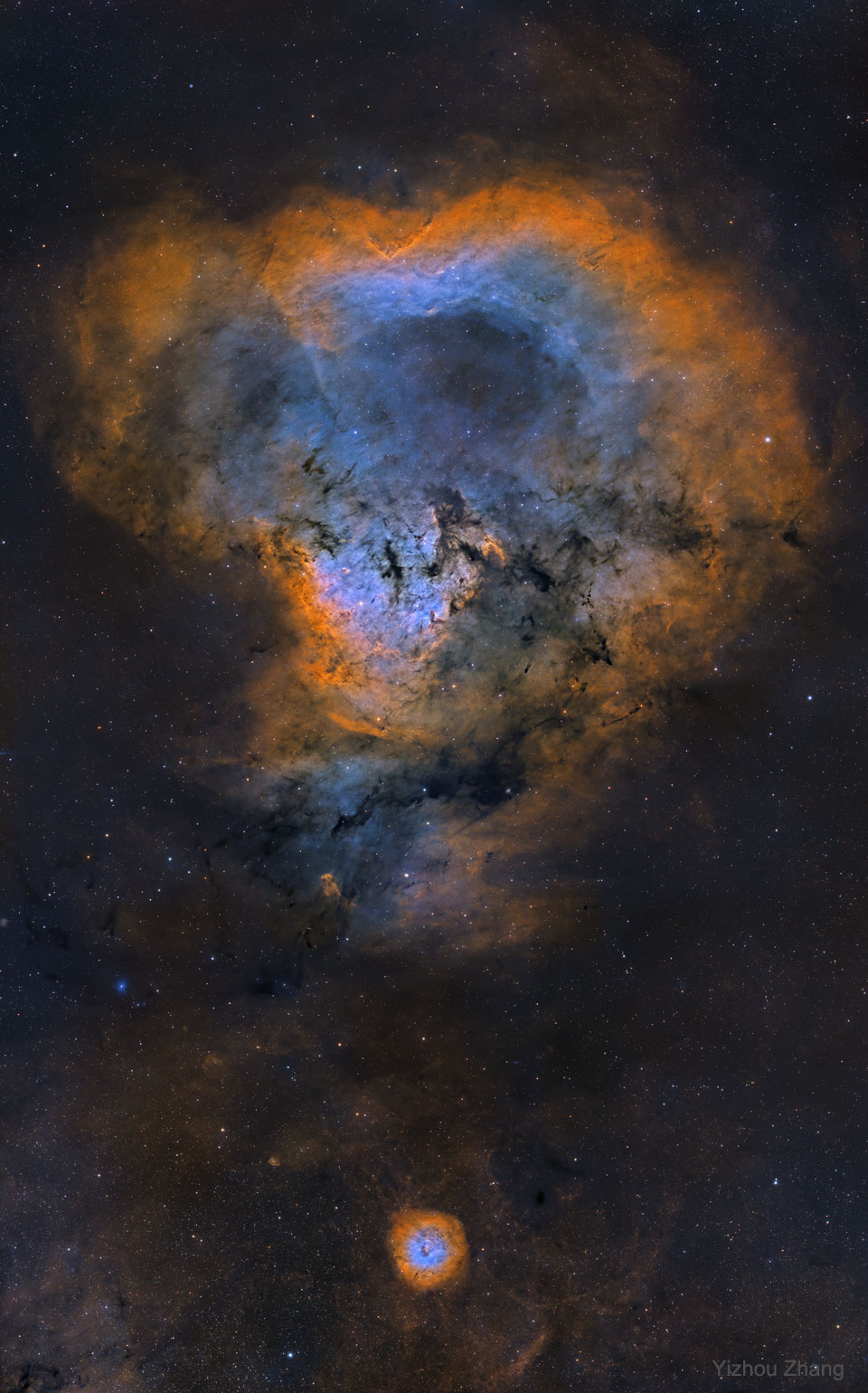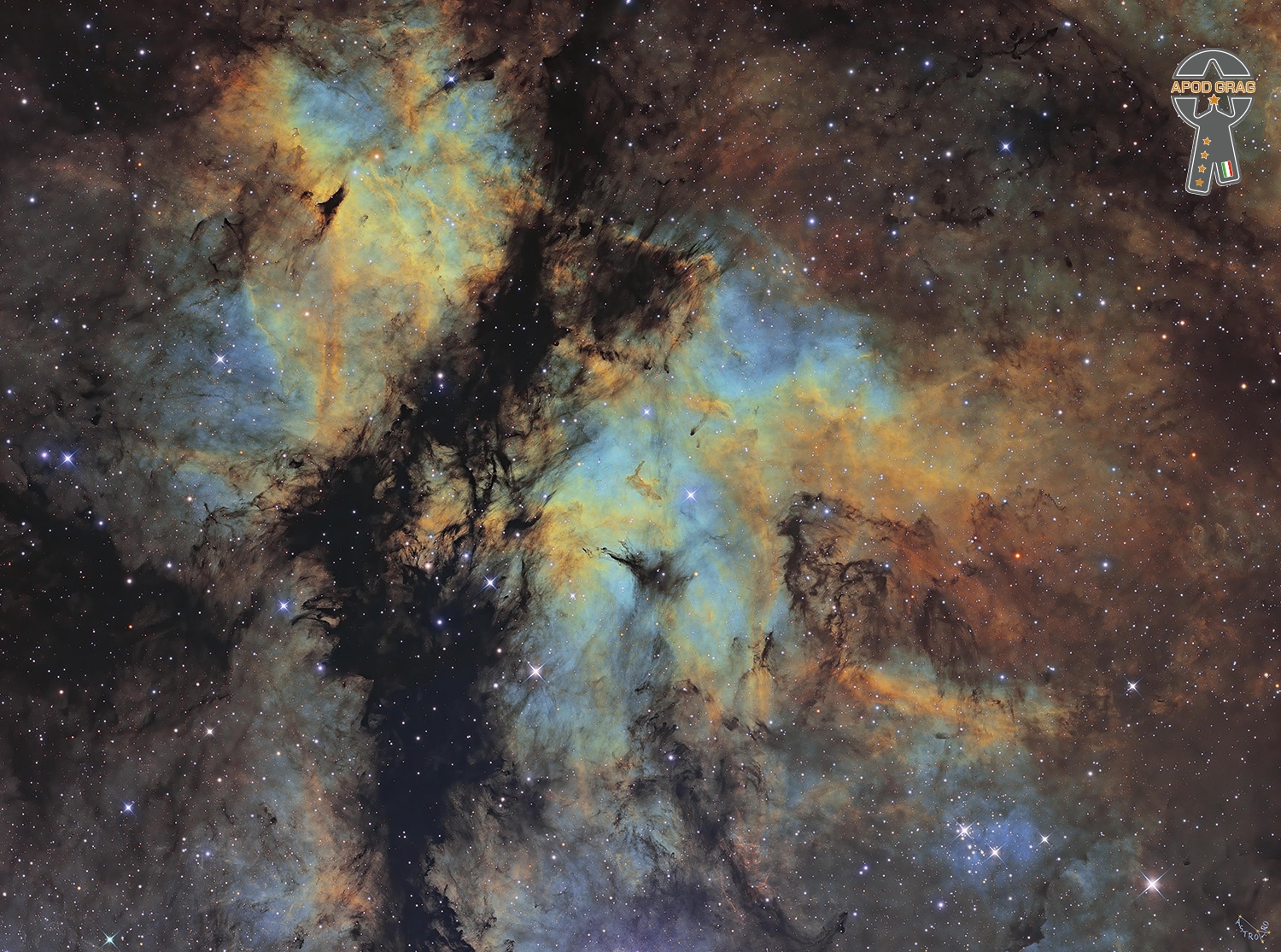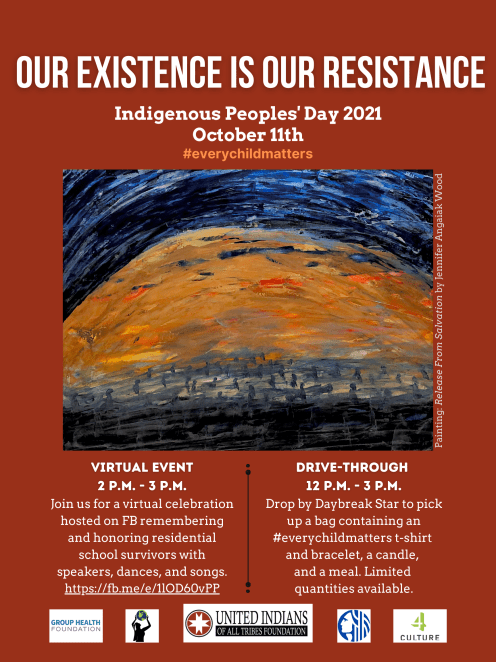Blog
At the edge of a giant molecular cloud toward the northern constellation Cepheus, the glowing star forming region NGC 7822 lies about 3,000 light-years away. Within the nebula, bright edges and dark shapes stand out in this colorful and detailed skyscape. The 9-panel mosaic, taken over 28 nights with a small telescope in Texas, includes data from narrowband filters, mapping emission from atomic oxygen, hydrogen, and sulfur into blue, green, and red hues. The emission line and color combination has become well-known as the Hubble palette. The atomic emission is powered by energetic radiation from the central hot stars. Their powerful winds and radiation sculpt and erode the denser pillar shapes and clear out a characteristic cavity light-years across the center of the natal cloud. Stars could still be forming inside the pillars by gravitational collapse but as the pillars are eroded away, any forming stars will ultimately be cut off from their reservoir of star stuff. This field of view spans over 40 light-years across at the estimated distance of NGC 7822.

Paul Frederic Simon (born October 13, 1941) is an American musician, singer, songwriter, actor and producer. Simon’s musical career has spanned over six decades. He is widely regarded as one of the most acclaimed songwriters in popular music history.
Simon formed the duo Simon & Garfunkel with his schoolfriend Art Garfunkel in 1956. They released five studio albums and became one of the most acclaimed groups of the 1960s. Simon composed nearly all of their songs, including “The Sound of Silence“, “Mrs. Robinson“, “America“, “Bridge over Troubled Water“, and “The Boxer“.
After Simon & Garfunkel split in 1970, Simon recorded three acclaimed albums over the following five years, all of which charted in the top 5 on the Billboard 200. His 1972 self-titled album contained the hit songs “Mother and Child Reunion” and “Me and Julio Down by the Schoolyard“. The 1975 album Still Crazy After All These Years, which featured guest vocals from Garfunkel, was his first number-one solo album, and featured the number 1 hit single “50 Ways to Leave Your Lover“, among other top-40 songs such as “Still Crazy After All These Years“, “Gone at Last“, and “My Little Town“.
Simon reunited with Garfunkel for a performance in New York Central Park in 1981, drawing half a million spectators, followed by a world tour with Garfunkel. After a career slump, Simon released Graceland, an album inspired by South African township music, which sold 14 million copies worldwide and remains his most popular and acclaimed solo work. A number of hit singles were released from the album, including “You Can Call Me Al“, “The Boy in the Bubble“, and “Diamonds on the Soles of Her Shoes“. It won the Grammy Award for Album of the Year in 1987.
Simon continued to tour throughout the 1990s, wrote a Broadway musical, The Capeman, and recorded a companion album, Songs from The Capeman which was released in 1997. His 2000 album You’re the One was nominated again for Album of the Year honors. He followed that album up with several years of touring, including another reunion tour with Garfunkel, and released Surprise, his last album of the decade, in 2006. In 2016 he released Stranger to Stranger, which debuted at number 3 on the Billboard Album Chart and number 1 the UK Albums Chart, and marked his greatest commercial and critical success in thirty years. His most recent album is 2018’s In the Blue Light, which contains re-arrangements of lesser-known songs from his prior albums.
Simon has earned sixteen Grammy Awards for his solo and collaborative work, including three for Album of the Year (Bridge Over Troubled Water, Still Crazy After All These Years, and Graceland), and a Lifetime Achievement Award. He is a two-time inductee into the Rock and Roll Hall of Fame: first in 1990 as a member of Simon & Garfunkel and again in 2001 for his solo career. In 2006 he was selected as one of the “100 People Who Shaped the World” by Time. In 2011, Rolling Stone named Simon one of the 100 greatest guitarists, and in 2015 he was ranked eighth in their list of the 100 Greatest Songwriters of All Time. Simon was the first recipient of the Library of Congress‘s Gershwin Prize for Popular Song in 2007.
more...Pharoah Sanders (born Farrell Sanders, October 13, 1940) is an American jazz saxophonist. A member of John Coltrane‘s groups of the mid-1960s, Sanders is known for his overblowing, harmonic, and multiphonic techniques on the saxophone, as well as his use of “sheets of sound“. He has released over 30 albums as a leader and has collaborated extensively with Leon Thomas, Alice Coltrane and Rinai Maurice, among others. Saxophonist Ornette Coleman described him as “probably the best tenor player in the world”.
Sanders’ music has been called “spiritual jazz” due to his inspiration in religious concepts such as Karma and Tawhid, and his rich, meditative aesthetic. This style is seen as a continuation of Coltrane’s work on albums such as A Love Supreme As a result, Sanders is considered a disciple of Coltrane or, as Albert Ayler said, “Trane was the Father, Pharoah was the Son, I am the Holy Ghost”.
Pharoah Sanders was born on October 13, 1940, in Little Rock, Arkansas, United States. His mother worked as a cook in a school cafeteria, and his father worked for the City of Little Rock. An only child, Sanders began his musical career accompanying church hymns on clarinet. His initial artistic accomplishments were in the visual arts, but when he was at Scipio Jones High School in North Little Rock, Sanders began playing the tenor saxophone. The band director, Jimmy Cannon, was also a saxophone player and introduced Sanders to jazz. When Cannon left, Sanders, although still a student, took over as the band director until a permanent director could be found.
During the late 1950s, Sanders would often sneak into African-American clubs in downtown Little Rock to play with acts that were passing through. At the time, Little Rock was part of the touring route through Memphis, Tennessee, and Hot Springs for R&B and jazz musicians. Sanders found himself limited by the state’s segregation and the R&B and jazz standards that dominated the Little Rock music scene.
more...Leon Konitz (October 13, 1927 – April 15, 2020) was an American composer and alto saxophonist.
He performed successfully in a wide range of jazz styles, including bebop, cool jazz, and avant-garde jazz. Konitz’s association with the cool jazz movement of the 1940s and 1950s includes participation in Miles Davis‘s Birth of the Cool sessions and his work with pianist Lennie Tristano. He was one of relatively few alto saxophonists of this era to retain a distinctive style, when Charlie Parker exerted a massive influence. Like other students of Tristano, Konitz improvised long, melodic lines with the rhythmic interest coming from odd accents, or odd note groupings suggestive of the imposition of one time signature over another. Other saxophonists were strongly influenced by Konitz, such as Paul Desmond and Art Pepper.
He died during the COVID-19 pandemic due to complications brought on by the disease.
Leon Konitz was born on October 13, 1927, in Chicago. He was the youngest of three sons of Jewish immigrant parents. His Austrian father, Abraham, operated a laundry business in the back of which the family lived. His mother, Anna, had emigrated from Russia. The family spoke Yiddish at home and were not religiously observant. Neither of his parents were musical but were supportive of Konitz’s interest in music.
At the age of eleven, inspired by Benny Goodman, Konitz received his first clarinet. He received classical training from Lou Honig who also taught Johnny Griffin and Eddie Harris. A year later, his admiration for Lester Young led him to drop the instrument in favour of the tenor saxophone. He eventually moved from tenor to alto. He received instruction on the saxophone from Santy Runyon. Konitz’s early influences were big band horn players such as Johnny Hodges, Roy Eldridge, Willie Smith and Scoops Carry. He also greatly admired Louis Armstrong and credited the influence Benny Carter’s solo on ‘I Can’t Believe that You’re in Love with Me’ had on him.
more...Raymond Matthews Brown (October 13, 1926 – July 2, 2002) was an American jazz double bassist known for extensive work with Oscar Petersonand Ella Fitzgerald. Ray Brown was born October 13, 1926, in Pittsburgh, Pennsylvania and took piano lessons from the age of eight. After noticing how many pianists attended his high school, he thought of taking up the trombone, but was unable to afford one. With a vacancy in the high school jazz orchestra, he took up the upright bass.
A major early influence on Brown’s bass playing was Jimmy Blanton, the bassist in the Duke Ellington band. As a young man Brown became increasingly well known in the Pittsburgh jazz scene, with his first experiences playing in bands with the Jimmy Hinsley Sextet and the Snookum Russell band. After graduating high school, having heard stories about the burgeoning jazz scene on 52nd Street in New York City, he bought a one-way ticket to New York. He arrived in New York at the age of 20, met up with Hank Jones, with whom he had previously worked, and was introduced to Dizzy Gillespie, who was looking for a bass player. Gillespie hired Brown on the spot, and he soon played with such established musicians as Art Tatum and Charlie Parker. In 1948, Brown left Dizzy’s band to start a trio with Hank Jones and Charlie Smith.
more...Arthur Tatum Jr. (/ˈteɪtəm/, October 13, 1909 – November 5, 1956 Toledo, OH) was an American jazz pianist who is widely regarded as one of the greatest in his field.[1][2] From early in his career, Tatum’s technical ability was regarded by fellow musicians as extraordinary. Many pianists attempted to copy him; others questioned their own skills after encountering him, and some even switched instruments in response. In addition to being acclaimed for his virtuoso technique, Tatum extended the vocabulary and boundaries of jazz piano far beyond his initial stride influences, and established new ground in jazz through innovative use of reharmonization, voicing, and bitonality.
Tatum grew up in Toledo, Ohio, where he began playing piano professionally and had his own radio program, rebroadcast nationwide, while still in his teens. He left Toledo in 1932 and had residencies as a solo pianist at clubs in major urban centers including New York, Chicago, and Los Angeles. In that decade, he settled into a pattern that he followed for most of his career – paid performances followed by long after-hours playing, all accompanied by prodigious consumption of alcohol. He was said to be more spontaneous and creative in these after-hours venues, and although the drinking did not negatively affect his playing, it did damage his health.
In the 1940s, Tatum led a commercially successful trio for a short time and began playing in more formal jazz concert settings, including at Norman Granz-produced Jazz at the Philharmonic events. His popularity diminished towards the end of the decade, as he continued to play in his own style, ignoring the rise of bebop. Granz recorded Tatum extensively in solo and small group formats in the mid-1950s, with the last session occurring only two months before the pianist’s death from uremia at the age of 47.
more...Born in 1938, Mr Moloney grew up in a musical family in north County Dublin.A piper, tin whistle player and composer, he formed The Chieftains in 1962. President Higgins said people around the world inspired by Mr Moloney’s music “will have learnt with great sadness” of his passing. He said Mr Maloney’s “extraordinary skills” were at the forefront of the renaissance of interest in Irish music. “He brought a love of Irish music not just to the diaspora, but to all those across the world who heard his music and appreciated it for its own sake as it transcended all musical boundaries,” he said.
The Sadr Region (also known as IC 1318 or the Gamma Cygni Nebula) is the diffuse emission nebula surrounding Sadr (γ Cygni) at the center of Cygnus’s cross. The Sadr Region is one of the surrounding nebulous regions; others include the Butterfly Nebula and the Crescent Nebula. It contains many dark nebulae in addition to the emission diffuse nebulae.
Sadr itself has approximately a magnitude of 2.2. The nebulous regions around the region are also fairly bright

Edward E. Cherry Jr. (October 12, 1954) is an American jazz guitarist and studio musician. Cherry is perhaps best known for his long association with trumpeter Dizzy Gillespie, with whom he performed from 1978 until shortly before Gillespie’s death in 1993. Since that time, he has worked with Paquito D’Rivera, Jon Faddis, John Patton, Hamiet Bluiett, Henry Threadgill, and Paula West. He has recorded a number of albums as a leader.
more...Frank Floyd, known as Harmonica Frank (October 11, 1908 – August 7, 1984) was an American blues singer, guitarist and harmonicist.
Frank Floyd was born in Toccopola, Mississippi, the son of itinerant parents who separated without giving him a name, though he is recorded in the 1910 census as Shankles Floyd. He was raised by his sharecropping grandparents, who died while he was a teenager. He taught himself to play harmonica when he was 10 years old, and he eventually learned guitar. He gave himself the name Frank Floyd, and began performing in the 1920s for traveling carnivals and medicine shows.
He learned many types of folk music and became a mimic, effortlessly switching from humorous hillbilly ballads to deep country blues.
With his self-taught harmonica technique, he was a one-man band, able to play the instrument without his hands or the need for a neck brace. While also playing guitar, he perfected a technique of manipulating the harmonica with his mouth while he sang out of the other side. He could also play harmonica with his nose and thus play two harmonicas at once, a skill he shared with blues harp players Walter Horton and Gus Cannon’s partner Noah Lewis.
more...Celebrating Indigenous Peoples Day and Healing the Wounds of centuries of Colonial Abuse.
more...NGC 4666 takes centre stage in this image from the NASA/ESA Hubble Space Telescope. This majestic spiral galaxy lies about 80 million light-years away in the constellation Virgo, and is undergoing a particularly intense episode of star formation. Astronomers refer to galaxies which are forming stars anomalously quickly as starburst galaxies. NGC 4666’s starburst is thought to be due to gravitational interactions with its unruly neighbours — including the nearby galaxy NGC 4668 and a dwarf galaxy. NGC 4666’s burst of star formation is driving an unusual form of extreme galactic weather known as a superwind — a gigantic transfer of gas from the bright central heart of the galaxy out into space. This superwind is the result of driving winds from short-lived massive stars formed during NGC 4666’s starburst as well as spectacularly energetic supernova explosions. Two such supernova explosions have been seen in NGC 4666 within the last decade — one in 2014 and the other in 2019. The star which led to the 2019 supernova was recently determined to be 19 times as massive as our Sun! At peak, supernovae are often the brightest sources of light in their galaxies, shining so bright that they can be seen clear across the Universe. The 2014 supernova in NGC 4666 is still active in this image, but more than 900 days after it peaked, the supernova has faded from its former glory and looks like just one more star in this busy galaxy. Though the torrent of superheated gas emanating from NGC 4666 is truly vast in scale — extending for tens of thousands of light-years — it is invisible in this image. The superwind’s extremely high temperature makes it stand out as a luminous plume in x-ray or radio observations, but it doesn’t show up at the visible wavelengths imaged by Hubble’s Wide Field Camera 3.

Lester Bowie (October 11, 1941 – November 8, 1999) was an American jazz trumpet player and composer. He was a member of the Association for the Advancement of Creative Musicians and co-founded the Art Ensemble of Chicago.
Born in the historic village of Bartonsville in Frederick County, Maryland, United States, Bowie grew up in St Louis, Missouri. At the age of five he started studying the trumpet with his father, a professional musician. He played with blues musicians such as Little Milton and Albert King, and rhythm and blues stars such as Solomon Burke, Joe Tex, and Rufus Thomas. In 1965, he became Fontella Bass‘s musical director and husband. He was a co-founder of Black Artists Group (BAG) in St Louis.
In 1966, he moved to Chicago, where he worked as a studio musician, and met Muhal Richard Abrams and Roscoe Mitchell and became a member of the AACM. In 1968, he founded the Art Ensemble of Chicago[2] with Mitchell, Joseph Jarman, and Malachi Favors. He remained a member of this group for the rest of his life, and was also a member of Jack DeJohnette‘s New Directions quartet. He lived and worked in Jamaica and Nigeria, and played and recorded with Fela Kuti. Bowie’s onstage appearance, in a white lab coat, with his goatee waxed into two points, was an important part of the Art Ensemble’s stage show.
more...Billy Higgins (October 11, 1936 – May 3, 2001) was an American jazz drummer. He played mainly free jazz and hard bop.
Higgins was born in Los Angeles, California, United States. Higgins played on Ornette Coleman‘s first records, beginning in 1958. He then freelanced extensively with hard bop and other post-bop players, including Donald Byrd, Dexter Gordon, Grant Green, Herbie Hancock, Joe Henderson, Don Cherry, Paul Horn, Milt Jackson, Jackie McLean, Pat Metheny, Hank Mobley, Thelonious Monk, Lee Morgan, David Murray, Art Pepper, Sonny Rollins, Mal Waldron, and Cedar Walton. He was one of the house drummers for Blue Note Records and played on dozens of Blue Note albums of the 1960s. He also collaborated with composer La Monte Young and guitarist Sandy Bull.
In his career, he played on over 700 recordings, including recordings of rock and funk. He appeared as a jazz drummer in the 2001 movie, Southlander.
In 1989, Higgins cofounded a cultural center, The World Stage, in Los Angeles to encourage and promote younger jazz musicians. The center provides workshops in performance and writing, as well as concerts and recordings. Higgins also taught in the jazz studies program at the University of California, Los Angeles.
more...More Posts
- Allan Clarke
- Cosmo IC 2177
- Nabil Totah
- Billy Bland
- Stanley Turrentine
- World Music Halima Khalif Magool
- Daily Roots Perry King Tubby
- UNITE
- STOP THIS NOW
- What is Happening to Our Country
- UNRAVELING ISLAM pt 3
- Lewis Carrol Knowing
- Rebecca Rice Memorial
- Erev Shabbat Service Temple Israel
- Cosmo Hickson 44/Arp 316
- Alfredo “Chocolate” Armenteros
- Elmer Bernstein
- Hugh Masekela
- Muddy Waters
- Flamenco Fridays Frijones and Juaquin de la Paula
